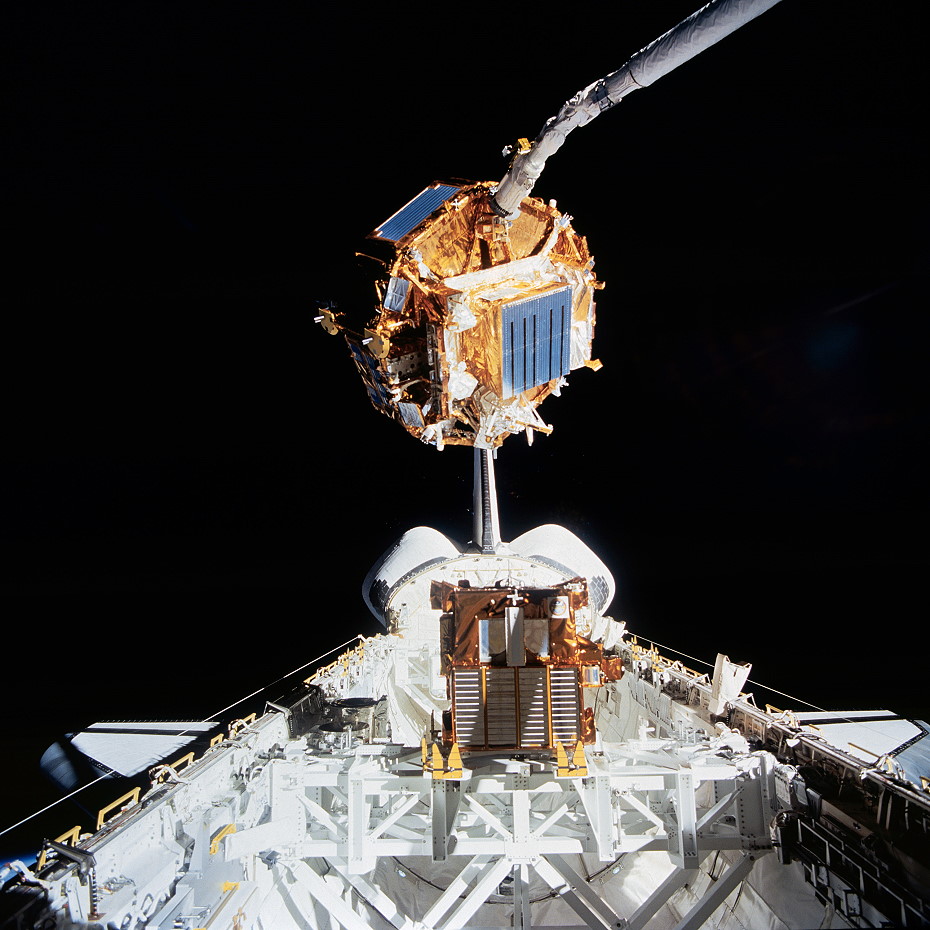
Nineteen years ago, today, on 11 January 1996, Shuttle Endeavour and a six-man crew—Commander Brian Duffy, Pilot Brent Jett, and Mission Specialists Leroy Chiao, Winston Scott, Dan Barry, and Japanese astronaut Koichi Wakata—rocketed into orbit in pursuit of Japan’s Space Flyer Unit (SFU). Launched 10 months earlier, the octagonal satellite carried a mixture of biological, technological, and astronomical experiments, and it was the task of STS-72 to recover it from orbit and bring it back to Earth. Additionally, as described in yesterday’s AmericaSpace history article, the crew was expected to deploy and retrieve another satellite, support several experiments, and perform two EVAs to support critical hardware tests for the International Space Station (ISS).
However, the final stages of the SFU retrieval did not go entirely smoothly. The satellite had earlier been placed onto internal battery power, ahead of the commands for it to close its solar arrays. Although they retracted correctly, they did not properly latch into place. As a result, it was decided to discard both array canisters. The astronauts and flight controllers had trained for just such an eventuality in their contingency simulations. As Endeavour and the SFU orbited high above Africa, the canisters were jettisoned (the first at 4:35 a.m., the second at 4:47 a.m.) from the satellite to ensure that they did not complicate the retrieval. Finally, the go-ahead was issued to approach the SFU for retrieval, and Duffy executed a small yaw manoeuvre to align the RMS grapple fixture with the satellite’s capture mechanism. With the two spacecraft now high above the Gulf of Mexico, near the western tip of Cuba, Wakata grappled the SFU at 5:57 am, about 91 minutes later than planned. He then lowered it gently into the payload bay, locking it into place at 6:39 a.m. by closing four retention latches. The internal batteries were bypassed and a remotely-operated electrical cable was connected to the side of the satellite. To honor their success, the crew were awakened for their next day in space by the traditional Japanese song, “Sea in Springtime.”
Success had been accomplished by a crew which balanced only two experienced astronauts with four first-timers. “The crew experience was night and day between the two,” veteran Leroy Chiao admitted, but stressed that “We were a very cohesive crew.” In addition to retrieving a Japanese satellite, STS-72 featured a multitude of scientific and technological payloads, including a deployable Shuttle-Pointed Autonomous Research Tool for Astronomy (SPARTAN) free-flying spacecraft equipped with experiments for NASA’s Office of Aeronautics and Space Technology (OAST). Designated “OAST-Flyer,” the deployment of the 2,650-pound (1,200-kg) satellite was conducted early on 14 January. Following a thorough systems check, latches holding it in the payload bay were released and Koichi Wakata grappled OAST-Flyer with the RMS arm and lifted it to its pre-deployment position. He released the satellite at 6:32 a.m. EST for two days of autonomous activities.
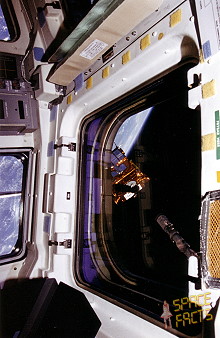
Aboard OAST-Flyer were four experiments, three sponsored by NASA and a fourth by the Amateur Radio Association at the University of Maryland. The Return Flux Experiment (REFLEX) tested the accuracy of computer models predicting the effect of contaminants on sensitive surfaces, such as lenses, sensors, and scientific instruments, in the space environment. In addition to measuring the erosion of surface coatings, the experiment investigated molecular “backscattering” as the spacecraft issued tiny particles of dirt, which went on to collide with other particles and bounce back onto the spacecraft. The Solar Exposure to Laser Ordnance Device (SELODE) sought to evaluate five new techniques of firing pyrotechnics using fibre optic laser pulses, rather than electricity. The University of Maryland’s SPARTAN Packet Radio Experiment (SPRE) supported amateur radio applications, with GPS data provided through the fourth OAST-Flyer payload, the Global Positioning System Attitude Determination and Control Experiment (GADACS). This latter investigation determined the attitude of the satellite, its location and velocity, and provided accurate timing to execute SPARTAN thruster firings. It marked the first occasion on which a spacecraft had been controlled using Global Positioning System (GPS) technology, and a similar receiver was also located aboard Endeavour herself.
After deployment, OAST-Flyer executed a 45-degree pirouette to confirm that its attitude-control system was functioning properly. Pilot Brent Jett then maneuvered the shuttle to a distance of about 44 miles (72 km), with periodic thruster firings over the following two days to maintain a distance of about 103 miles (167 km) between the two spacecraft. At the conclusion of its operations, OAST-Flyer maneuvered itself into the correct orientation and awaited the return of Endeavour, early on 16 January. About 9.3 miles (15 km) “behind” the satellite, and two hours ahead of capture, Duffy pulsed the RCS thrusters for a TI burn which positioned the shuttle onto an R-Bar rendezvous, approaching OAST-Flyer from “below.” As with the earlier SFU operation, the rendezvous radar and hand-held laser ranging device offered critical support during proximity operations. At a distance of a half-mile (0.8 km), and just 45 minutes before the scheduled retrieval time, Duffy assumed manual control, firing Endeavour’s thrusters directly toward the satellite for braking, until he reached 216 feet (66 meters), at which point he transitioned to Low-Z mode to avoid contaminating OAST-Flyer’s experiments. Closing to within 33 feet (10 meters), Duffy maintained his position, enabling Wakata to grapple the satellite, precisely on time, at 4:47 a.m. EST. Shortly thereafter, it was returned to its berth in the payload bay for the return to Earth.
Betwixt the deployment and retrieval of OAST-Flyer, the first of STS-72’s two EVAs was conducted in the early hours of 15 January. In a manner not dissimilar to the spacewalk performed by Jim Voss and Mike Gernhardt on STS-69 in September 1995, it formed part of NASA’s EVA Development Flight Test (EDFT) initiative to evaluate tools and techniques for the construction and maintenance of the ISS. When the crew was assigned in December 1994, it was intended that Leroy Chiao and Dan Barry would perform both spacewalks, but as their training developed, it was decided to incorporate Winston Scott into the plan, thereby increasing their all-round EVA expertise. As a result, Chiao (designated “EV1,” with red stripes on the legs of his suit) and Barry (“EV2,” wearing a pure-white suit) would perform the first spacewalk, with Scott choreographing their every mode from inside Endeavour’s cabin. Two days later, Chiao (EV1) and Scott (designated “EV3,” with broken red stripes on the legs of his suit) would venture outside on the second spacewalk, with Barry choreographing their actions from the flight deck.
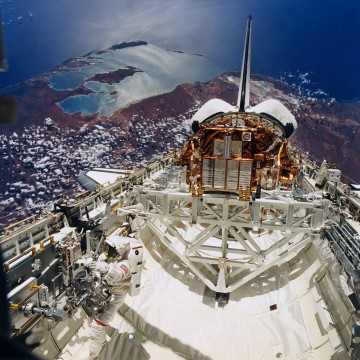
At the time of STS-72, Chiao was 35 years old, somewhat younger than the 42-year-old Barry and the 45-year-old Scott. None of them had previously performed an EVA, but it made sense for Chiao—the only one of them with prior shuttle flight experience—to serve as the chief spacewalker. It set him up for some interesting conversations with Barry. “Dan was an interesting guy,” Chiao told the NASA oral historian. “He was flying his first mission and he felt like he should have had my job. He thought he should be the lead EVA guy … and he let me know it, which set up an interesting relationship! There was a little bit of friction between Dan and me for that reason, but we worked through it.” For Barry and Scott, both making their first shuttle flights, the opportunity to travel into orbit was sweetened with the promise of one spacewalk apiece.
So it was that at 12:35 a.m. EST on 15 January 1996, Leroy Chiao and Dan Barry transferred their space suits’ life-support utilities to internal battery power, pushed open the outer airlock hatch, and floated into Endeavour’s floodlit payload bay for what they expected to be around six hours of operations. Although he had one prior shuttle flight to his credit, Chiao’s breath was truly taken away by the sensation of actually being in space, with nothing but a visor between him and the cosmos. “Getting to do spacewalks was a surreal experience,” he told the NASA oral historian, years later, “seeing the Earth with peripheral vision involved, really feeling like the Earth was a ball. Of course, looking through the window, you know it’s a ball, but there’s something about looking through the window and then being out there with an unrestricted view that really made it feel like it was three-dimensional for the first time.” Flight Surgeon Phil Stepaniak later told Chiao that his heart rate spiked as soon as the airlock hatch opened, then quickly returned to normal as he began work.
With Jett and Wakata operating the RMS arm, and Scott choreographing their every move from the aft flight deck, the two men quickly set to work on their respective tasks. They assembled and tested the Lockheed Martin-built Portable Work Platform (PWP). Designed as a prototype for a mobile EVA worksite to be located at the end of the Space Station Remote Manipulator System (SSRMS), the PWP included a temporary equipment restraint aid to hold ORUs, a portable foot restraint stanchion with tool boards, sliding locks, and rigid tether sockets and an Articulating Portable Foot Restraint (APFR). After assembling the PWP, Chiao and Barry installed it onto the end of the RMS, allowing Jett to grapple various pieces of hardware intended to hold large modular components. In a sense, this work closely mirrored the manner in which equipment and avionics boxes would be moved backwards and forwards during ISS assembly.
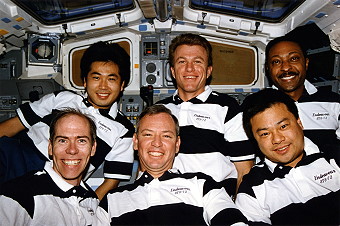
Meanwhile, the spacewalkers set to work on their next task, which was the unfurling of the 250-pound (113-kg) Rigid Umbilical (RU), which simulated an umbilical connection which might someday link ISS modules to the electricity-generating solar arrays and supporting truss structure. Stored on the port-side wall of Endeavour’s payload bay for ascent, the RU included a cable tray, which housed a range of avionic and fluid lines, and measured 8 feet (2.4 meters) long in its folded configuration and 17.3 feet (5.3 meters) long when fully deployed. Chiao and Barry mated one end of the umbilical to a connector (known as the Port Rigid Umbilical Mount) on the port side of the payload bay, and attached the other end to a connector on the starboard wall. The spacewalkers then installed a series of simulated electrical and fluid connections and later partially unfolded the RU to simulate various positions planned for its attachment on the ISS. Most tasks, Chiao reported, could be completed without difficulty, although he felt that the Electronic Cuff Checklist (ECC)—a wrist-mounted portable computer to supplement written checklists for spacewalkers—was a good idea, but poorly executed, since solar glare made its display difficult to read and it also interfered with the space suit controls.
Toward the end of the EVA, during a brief quiet spell, Barry managed to catch a glimpse of stars. “We had a test at the very end of the spacewalk to test the lights mounted on our helmets,” he told a Smithsonian interviewer, years later. “To get the best test, we did something never done before during a spacewalk: we turned off all of the orbiter’s lights, which are so bright that they prevent spacewalkers from seeing the stars.” Barry found that his helmet lights functioned perfectly well, and he could continue to work without problems, but when he switched them off he was plunged into icy darkness. “It was so black,” he explained, “I couldn’t see my hand. I waited for my eyes to adjust and was rewarded by millions of stars, faint at first, but eventually turning into brilliant points.”
Their work completed, the spacewalkers returned to the airlock and EVA-1 officially ended at 6:44 a.m. EST, after slightly more than six hours. “We’ll come out together [again], Leroy,” called Barry as the EVA drew to a close. “There’s going to be plenty of work to do for station.” Indeed, both men would perform spacewalks to assemble and maintain the ISS, later in their careers. With the following day, 16 January, devoted to the retrieval of OAST-Flyer, the second spacewalk, by Chiao and Scott, got underway at 12:40 a.m. EST on the 17th. Problems with donning their suits delayed the start time by about an hour, but once outside the astronauts stepped smartly through their tasks. Going outside for the second time was an interesting experience for Chiao. On his first EVA, his heart rate had spiked when the airlock hatch opened, but on this second occasion … it did not change at all. Talking to the flight surgeon after the mission, it seemed that his body and senses had almost gotten used to the experience. “It’s interesting how adaptable humans really are,” Chiao said, “and you get used to things.”
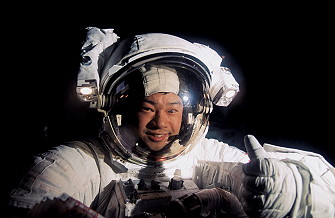
Scott entered a foot restraint and held himself still for 35 minutes as Endeavour manoeuvred into an orientation which would chill the payload bay, thus testing thermal modifications to his suit. These included battery-powered heating elements, just above the suit’s wrists, which provided warming of the astronauts’ fingers, together with thermal socks and toe caps and new, adjustable thermal “mittens.” Additionally, the modifications enabled the spacewalkers to shut off cooling water to their suits’ liquid cooling and ventilation garments, should they become too cold. During this 35-minute period, temperatures dropped to -122 degrees Celsius (-187.6 degrees Fahrenheit), and Scott reported that, although he was keenly aware of the cold, he remained comfortable. “If I felt that comfortable standing still,” he later told a post-mission debriefing panel, “I think I’d have been even warmer as a result of being busy.”
Pressing on with their work, the astronauts tested cable trays and clamps for ISS use. Leroy Chiao noted that cold temperatures threatened to make the handling of pressurized umbilicals difficult, and, certainly, both spacewalkers felt that the clamps caused hand fatigue and that larger connectors were more awkward to use than small ones. At times, they rocked backwards and forwards in their foot restraints to determine the levels of vibrational stress which might be imposed on space station structures. They also evaluated the Body Restraint Tether (BRT), previously tested on STS-69, which it was hoped would provide a method of stability for a spacewalker in places where a foot restraint might be unavailable. Essentially, the BRT provided a “third hand” for a spacewalker, whilst working. Tests of a new Utility Box, a slide wire, and a cable caddy were also performed, with NASA engineers reporting to journalists that the data returned from the STS-72 EVAs would be developed into the spacewalk plans for ISS assembly missions. Their work finished, Chiao and Scott returned inside Endeavour at 7:34 a.m. EST, after six hours and 54 minutes.
By this point, on 17 January, the bulk of the STS-72 mission tasks had been triumphantly completed: the OAST-Flyer deployment and retrieval operations had gone flawlessly, as had the two spacewalks, and a battery of experiments were running smoothly. In the payload bay, the Shuttle Solar Backscatter Ultraviolet (SSBUV) instrument flew for the final time, as part of ongoing efforts to calibrate the ozone-monitoring sensors aboard the National Oceanic and Atmospheric Administration’s NOAA-9 and NOAA-11 satellites, together with NASA’s Nimbus-7. Calibration “drift” of solar backscatter ultraviolet data from these three satellites had proven a cause for concern, in terms of the reliability of their data over time, and SSBUV was designed to be flown at least once per year.
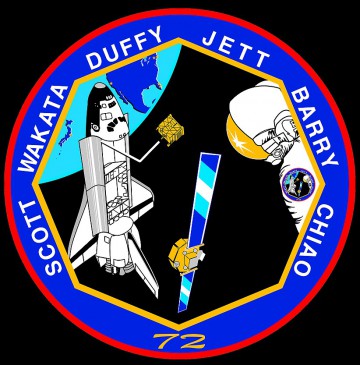
Before each of its missions, SSBUV was calibrated to a laboratory standard and recalibrated after its return to Earth. Housed inside a pair of GAS canisters, it flew annually from October 1989 until its final mission on STS-72. Its most alarming results described the marked depletion of stratospheric ozone since the mid-1980s—the much-publicized “ozone hole”—due partly to solar effects and atmospheric dynamics, but chiefly to the release of man-made carbon fluorides. This could prove catastrophic for life on Earth, because the effects observed over a four-year period, if extrapolated over half a century, could lead to a 60 percent ozone depletion. Elsewhere, affixed to a GAS Bridge Assembly (GBA) in the payload bay, the Thermal Energy Storage (TES) experiment focused on the long-duration behavior of thermal energy storage fluoride salts which underwent repeated cycles of melting and freezing in the microgravity environment. Such salts were under consideration for use in advanced space-based solar power systems, and a clear understanding of their performance was acutely necessary. Within Endeavour’s crew cabin, protein crystal growth research and National Institutes of Health (NIH) studies of the development of newborn rats were performed.
Only the most minor of problems troubled the shuttle herself, with flight controllers keeping a close watch over a component in the flash evaporator system, part of Endeavour’s coolant network. In response to the concern, as Chiao and Scott began EVA-2, Mission Control repressurized the cabin to help warm the orbiter and successfully dislodged ice from the flash evaporator. Of greater concern were colder-than-expected temperatures observed on a fuel line of the SFU satellite, whilst in the payload bay, with fears centering on the possibility of a dangerous hydrazine leak if it froze. However, its thermostats were considered to be operating correctly and maintaining hydrazine temperatures at acceptable levels, although procedures to warm the SFU’s fuel lines were called up later in the flight and Duffy accordingly maneuvered Endeavour into a warmer attitude.
With all mission objectives accomplished, Duffy and Jett guided Endeavour smoothly to a touchdown on Runway 15 at the Kennedy Space Center (KSC) at 2:41:41 a.m. EST on 20 January, completing a mission of almost nine full days in length. NASA’s first shuttle mission of 1996 had demonstrated many of the requirements which would be critical in the construction of the ISS … and in very good time. By year’s end, the first crews to occupy and build the multi-national orbiting outpost would have begun training.
This is part of a series of history articles, which will appear each weekend, barring any major news stories. Next week’s article will focus on STS-81, a shuttle mission from January 1997, which visited Russia’s Mir space station … and gave a radio show host the shock of his life.
Want to keep up-to-date with all things space? Be sure to “Like” AmericaSpace on Facebook and follow us on Twitter: @AmericaSpace



